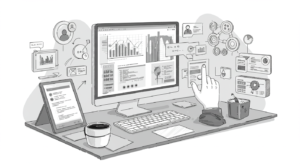Why Is Market Research So Expensive (It doesn't have to be...)

Market research is an essential tool when you need to understand their audience (always), refine products, and stay competitive. However, many organizations are taken aback by the high costs associated with a comprehensive research project. Understanding the components that contribute to these expenses can help you make informed decisions and optimize your research investments.
Targeted Samples
Value and rarity (incidence rate): One of the primary drivers of market research costs is the challenge of obtaining responses from highly specific or niche audiences. For instance, recruiting a neurosurgeon who graduated from Harvard to participate in a survey is significantly more expensive than engaging a barista. This disparity is due to two main factors: the value of the respondent’s time and the rarity of the demographic.
Sample size: Additionally, the size of the sample directly impacts the overall cost. Surveying 1,000 individuals will naturally incur higher expenses than surveying 100, even if the target demographic remains constant. Larger samples require more resources for recruitment, data collection, and analysis.
Incentives and Respondent Motivation
To encourage participation, especially among hard-to-reach demographics, incentives are almost always recommended. These can range from monetary compensation to exclusive access to products or services. The more exclusive or high-value the target audience, the more substantial the incentive required, further increasing the overall cost of the research project.
Infrastructure and Operational Overheads
The infrastructure of the research organization conducting the study also plays a significant role in the cost. Essential components, such as experienced researchers with backgrounds in statistics and analytics, are invaluable. However, other elements, like lavish offices or extensive advertising budgets, may not directly contribute to the quality of the research but still inflate costs.
When selecting a research provider, prioritize those who:
- Have rigorous controls for monitoring sample quality.
- Offer top-notch customer service.
- Demonstrate a clear understanding of project specifications.
- Are people you would want to work with
- Provide transparency in their pricing structures
Spot Trender, for example, emphasizes lean operations without compromising on quality, ensuring clients receive value-driven research solutions.
Customization and Complexity
Customized research designs tailored to specific business needs often require more time and resources than standardized approaches. Complex methodologies, such as maxdiff, conjoint analysis or segmentation studies, involve intricate planning and execution, leading to higher costs. Moreover, projects with multiple stakeholders or evolving objectives can experience scope creep, further escalating expenses.
Timelines and Methodological Choices
Accelerated timelines can significantly increase research costs. Rushed projects may require additional staffing, expedited data processing, and premium charges from vendors. Similarly, the choice of methodology impacts cost. Qualitative methods like in-depth interviews or focus groups are generally more time-consuming and expensive than quantitative surveys.
However, advancements in technology have introduced tools that streamline research processes. Platforms like Spot Trender enable rapid testing and insights generation, reducing both time and cost without sacrificing quality.
Data Quality Assurance
Ensuring the integrity of collected data is paramount. Poor data quality can lead to misguided business decisions, resulting in financial losses. Implementing rigorous quality assurance measures—such as verifying respondent identities, detecting fraudulent responses, and cleaning datasets—requires additional resources and expertise, contributing to the overall cost.
Ask tough questions: recent reports have highlighted concerns about survey fraud and the use of false respondents, emphasizing the need for robust data validation processes. Source: MRWeb
Red Flags When Choosing a Research Provider
To ensure you’re investing wisely, be cautious of research providers exhibiting the following red flags:
- Lack of transparency regarding sample sources and incentive structures.
- Unrealistically fast turnaround times without clear methodologies.
- Absence of documented quality assurance protocols.
- Inconsistent or vague pricing models.
- Generic deliverables lacking actionable insights.
- Limited access to experienced researchers or analysts.
- Poor or unverifiable client testimonials and reviews.
For a comprehensive checklist to evaluate potential research partners, download our guide: 12 Questions to Ask Before Hiring a Research Provider.
Conclusion
While market research can be a significant investment, understanding the factors that drive costs enables businesses to make informed decisions and optimize their research strategies. By focusing on essential components—such as targeting the right sample, ensuring data quality, and selecting the appropriate methodologies—organizations can achieve valuable insights without unnecessary expenditures.
Partnering with providers like Spot Trender, who prioritize efficiency and quality, ensures that your research investments yield actionable results and a strong return on investment.
How to configure HowTo in UAE?
So to get started, you will just need to drag-n-drop the HowTo widget in the Elementor editor. The How-to widget can be used on pages which contain a How-to in their title and describe steps to achieve certain requirements.

Required Tools:
Things Needed?
Steps to configure the HowTo widget:











